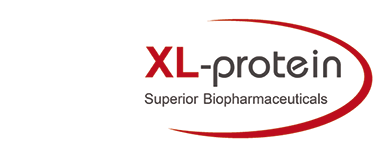Morath V., Maurer S., Feuchtinger A., Walser R., Schlapschy M., Bolze F., Metzler T., Bruder J., Steiger K., Walch A., Klingenspor M., Skerra A. (2025) Long-acting human PASylated leptin reaches the murine central nervous system and offers potential for optimized replacement therapy. Mol Pharm. 22, 3017-3032. ⇒ Full text
Binder U., Skerra A. (2024) Strategies for extending the half-life of biotherapeutics: successes and complications. Expert Opin Biol Ther. 25:1, 93-118 ⇒ Full text
Stamm S.M., Wagner R., Lang D.A., Skerra A., Gebauer M. (2024) Development of a clonal and high-yield mammalian cell line for the manufacturing of a hyperactive human DNase I with extended plasma half-life using PASylation® technology. Pharmaceutics 16, 967.
Jerschke E., Barkovsky M., Jung N., Neuberger H., Stenzel J., Eyer F., Skerra A., Geith S. (2023) In vivo neutralization of colchicine toxicity by a PASylated anticalin in a rat model. Toxicology 492, 153526.
Morath V., Brandt C., Deuschle F.C., Mendler C.T., Blechert B., Summer D., Barinka C., Decristoforo C., Weber W.A., Schwaiger M., Skerra A. (2023) Molecular design of 68Ga- and 89Zr-labeled anticalin radioligands for PET-imaging of PSMA-positive tumors. Mol Pharm. 20, 2490-2501.
Friedrich L., Kikuchi Y., Matsuda Y., Binder U., Skerra A. (2022) Efficient secretory production of proline/alanine/serine (PAS) biopolymers in Corynebacterium glutamicum yielding a monodisperse biological alternative to polyethylene glycol (PEG). Microb. Cell. Fact. 21, 227.
Schilz J., Clement C., Greiner F., Skerra A. (2022) Direct affinity purification of long-acting PASylated proteins with therapeutic potential using L-prolinamide for mild elution. Angew. Chem. Int. Ed. Engl. 61, e202200079.
Schilz J., Binder U., Friedrich L., Gebauer M., Lutz C., Schlapschy M., Schiefner A., Skerra A. (2021) Molecular recognition of structurally disordered Pro/Ala-rich sequences (PAS) by antibodies involves an Ala residue at the hot spot of the epitope. J. Mol. Biol. 433, 167113.
Binder U., Skerra A. (2020) PASylated Thymosin α1: a long-acting immunostimulatory peptide for applications in oncology and virology. Int. J. Mol. Sci. 22, E124.
Schiefner A., Walser R., Gebauer M., Skerra A. (2020) Proline/alanine-rich sequence (PAS) polypeptides as an alternative to PEG precipitants for protein crystallization. Acta Cryst. F76, 320-325.
Richter A., Knorr K., Schlapschy M., Robu S., Morath V., Mendler C., Yen H., Steiger K., Kiechle M., Weber W., Skerra A., Schwaiger M. (2020) First in-human medical imaging with a PASylated 89Zr-labeled anti-HER2 Fab-fragment in a patient with metastatic breast cancer. Nucl. Med. Mol. Imaging 54, 114–119.
Powers N. E., Swartzwelter B., Marchetti C., de Graaf D. M., Lerchner A., Schlapschy M., Datar R., Binder U., Edwards C. K. 3rd, Skerra A., Dinarello C. A. (2019) PASylation of IL-1 Receptor antagonist (IL-1Ra) retains IL-1 blockade and extends its duration in mouse urate crystal-induced peritonitis. J. Biol. Chem. 295, 868 –882.
Griffiths K., Binder U., McDowell W., Tommasi R., Frigerio M., Darby W.G., Hosking C.G., Renaud L., Machacek M., Lloyd P., Skerra A., Foley M. (2019) Half-life extension and non-human primate pharmacokinetic safety studies of i-body AD-114 targeting human CXCR4. MAbs 11, 1331-1340.
⇒ Abstract
Längin M., Mayr T., Reichart B., Michel S., Buchholz S., Guethoff S., Dashkevich A., Baehr A., Egerer S., Bauer A., Mihalj M., Panelli A., Issl L., Ying J., Fresch A.K., Buttgereit I., Mokelke M., Radan J., Werner F., Lutzmann I., Steen S., Sjöberg T., Paskevicius A., Qiuming L., Sfriso R., Rieben R., Dahlhoff M., Kessler B., Kemter E., Klett K., Hinkel R., Kupatt C., Falkenau A., Reu S., Ellgass R., Herzog R., Binder U., Wich G., Skerra A., Ayares D., Kind A., Schönmann U., Kaup F.J., Hagl C., Wolf E., Klymiuk N., Brenner P., Abicht J.M. (2018) Consistent success in life-supporting porcine cardiac xenotransplantation. Nature 564, 430-433.
Xia Y., Schlapschy M., Morath V., Roeder N., Vogt E.I., Stadler D., Cheng X., Dittmer U., Sutter K., Heikenwalder M., Skerra A., Protzer U. (2018) PASylated interferon α efficiently suppresses hepatitis B virus and induces anti-HBs seroconversion in HBV-transgenic mice. Antiviral Res. 161, 134-143.
Nganou-Makamdop K., Billingsley J.M., Yaffe Z., O’Connor G., Tharp G.K., Ransier A., Laboune F., Matus-Nicodemos R., Lerner A., Gharu L., Robertson J.M., Ford M.L., Schlapschy M., Kuhn N., Lensch A., Lifson J., Nason M., Skerra A., Schreiber G., Bosinger S.E., Douek D.C. (2018) Type I IFN signaling blockade by a PASylated antagonist during chronic SIV infection suppresses specific inflammatory pathways but does not alter T cell activation or virus replication. PLoS Pathog. 14, e1007246.
Gebauer M. & Skerra A. (2018) Prospects of PASylation® for the design of protein and peptide therapeutics with extended half-life and enhanced action. Bioorg. Med. Chem. 26, 2882-2887.
Griffiths K., Habiel D. M., Jaffar J., Binder U., Darby W. G., Hosking C. G., Skerra A., Westall G. P., Hogaboam C. M., Foley M. (2018) Anti-fibrotic effects of CXCR4-targeting i-body AD-114 in preclinical models of pulmonary fibrosis. Sci. Rep. 8, 3212.
Breibeck J. & Skerra A. (2018) The polypeptide biophysics of proline/alanine-rich sequences (PAS): Recombinant biopolymers with PEG-like properties. Biopolymers 108, e23069.
Binder U. & Skerra A. (2017) PASylation®: A versatile technology to extend drug delivery. Curr. Opin. Colloid Int. 31, 10-17.
Link
Kuhn N., Schmidt C. Q., Schlapschy M., Skerra A. (2016) PASylated Coversin, a C5-specific complement inhibitor with extended pharmacokinetics, shows enhanced anti-hemolytic activity in vitro. Bioconjug. Chem. 27, 2359-2371.
Link
Morath V., Bolze F., Schlapschy M., Schneider S., Sedlmayer F., Seyfarth K., Klingenspor M., Skerra A. (2015) PASylation of murine leptin leads to extended plasma half-life and enhanced in vivo efficacy. Mol. Pharmaceutics 12, 1431–1442.
Mendler C. T., Friedrich L., Laitinen I., Schlapschy M., Schwaiger M., Wester H.J., Skerra A. (2015) High contrast tumor imaging with radio-labeled antibody Fab fragments tailored for optimized pharmacokinetics via PASylation. MAbs 7, 96-109.
Harari D., Kuhn N., Abramovich R., Sasson K., Zozulya AL., Smith P., Schlapschy M., Aharoni R., Köster M., Eilam R., Skerra A., Schreiber G. (2014) Enhanced in vivo efficacy of a type I interferon superagonist with extended plasma half-life in a mouse model of multiple sclerosis. J. Biol. Chem. 289, 29014-29029.


